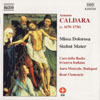Caldara Missa Dolorosa. Stabat Mater
There is little of greatness in this Stabat mater; the Missa dolorosa is more individual, but the performances are hardly top-notch
View record and artist detailsRecord and Artist Details
Composer or Director: Antonio Caldara
Label: Naxos
Magazine Review Date: 1/2001
Media Format: CD or Download
Media Runtime: 63
Mastering:
DDD
Catalogue Number: 8 554715

Tracks:
| Composition | Artist Credit |
|---|---|
| (12) Sinfonie a quattro, Movement: No. 6, Sant' Elena al Calvario |
Antonio Caldara, Composer
Antonio Caldara, Composer Aura Musicale Ensemble, Budapest René Clemencic, Conductor |
| (12) Sinfonie a quattro, Movement: Gioseffo che interpreta i sogni |
Antonio Caldara, Composer
Antonio Caldara, Composer Aura Musicale Ensemble, Budapest René Clemencic, Conductor |
| Stabat Mater |
Antonio Caldara, Composer
Antonio Caldara, Composer Aura Musicale Ensemble, Budapest Furio Zanasi, Baritone Lia Serafini, Soprano Marco Beasley, Tenor René Clemencic, Conductor Rosa Dominguez, Contralto (Female alto) Silvia Piccollo, Soprano Swiss-Italian Radio Chorus |
| Missa Dolorosa |
Antonio Caldara, Composer
Alfredo Graudini, Baritone Antonio Caldara, Composer Aura Musicale Ensemble, Budapest Fabian Schofrin, Alto Marco Beasley, Tenor Nadia Ragni, Soprano René Clemencic, Conductor Swiss-Italian Radio Chorus |
Author: Jonathan Freeman-Attwood
Although the paragraph on the rear of the disc proclaims Caldara’s Stabat mater to be ‘a major score of the period [which …] stands comparison with J S Bach’, I was left wondering, after this performance, whether it was the same piece. Caldara has long been brewing up for a major revival. He was, after all, a deputy Kapellmeister in Charles V’s opulent Viennese court, and his output is both prolific and intermittently distinguished.
Yet this programme of Lenten and Holy Week music is rarely spine- tingling beyond statutory suspensions and chromatic descents, and is certainly not in the Scarlatti or Pergolesi league of late-baroque musical ‘smells and bells’. The issue is compounded by some erratic pitching from the soloists, and the string playing hardly gets off to an auspicious start in the Sinfonia in G minor. There are flashes of darkly resonant doublings of voices and instruments with several impressive homophonic progressions, which the unabashed Mozart willingly absorbed into his church ‘language’. More sustained beauty and individuality can be found in the Missa dolorosa, from 1735, where Caldara exhibits his contrapuntal instincts with worthy formulae and, in the ‘Benedictus’, a touching melodic stillness. Some of the closed, ritornello sections reveal an accomplished craftsman, but when all is said and done, the invention is hardly inspired. Go carefully.'
Yet this programme of Lenten and Holy Week music is rarely spine- tingling beyond statutory suspensions and chromatic descents, and is certainly not in the Scarlatti or Pergolesi league of late-baroque musical ‘smells and bells’. The issue is compounded by some erratic pitching from the soloists, and the string playing hardly gets off to an auspicious start in the Sinfonia in G minor. There are flashes of darkly resonant doublings of voices and instruments with several impressive homophonic progressions, which the unabashed Mozart willingly absorbed into his church ‘language’. More sustained beauty and individuality can be found in the Missa dolorosa, from 1735, where Caldara exhibits his contrapuntal instincts with worthy formulae and, in the ‘Benedictus’, a touching melodic stillness. Some of the closed, ritornello sections reveal an accomplished craftsman, but when all is said and done, the invention is hardly inspired. Go carefully.'
Discover the world's largest classical music catalogue with Presto Music.

Gramophone Digital Club
- Digital Edition
- Digital Archive
- Reviews Database
- Full website access
From £8.75 / month
Subscribe
Gramophone Full Club
- Print Edition
- Digital Edition
- Digital Archive
- Reviews Database
- Full website access
From £11.00 / month
Subscribe
If you are a library, university or other organisation that would be interested in an institutional subscription to Gramophone please click here for further information.




